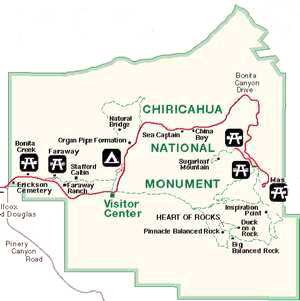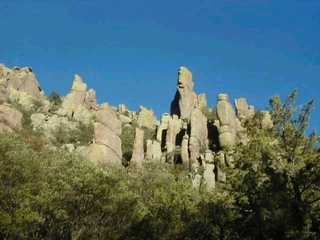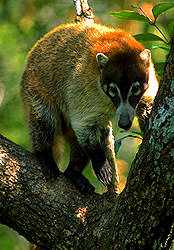 Exploring Chiricahua National Monument is exploring a fantasy world of
extraordinary rock sculptures that were created by the forces of nature
over millions of years. Called the Land of the Standing-Up Rocks by Chiricahua Apaches and later the "Wonderland of Rocks" by
pioneers, this northwest corner of the Chiricahua Mountains harbors
towering rock spires, massive stone columns, and balanced rocks weighing
hundreds of tons that perch delicately on small pedestals. Where hundreds
of these rocks occur together, such as in the Heart of Rocks the landscape
appears as a rugged badlands.
Exploring Chiricahua National Monument is exploring a fantasy world of
extraordinary rock sculptures that were created by the forces of nature
over millions of years. Called the Land of the Standing-Up Rocks by Chiricahua Apaches and later the "Wonderland of Rocks" by
pioneers, this northwest corner of the Chiricahua Mountains harbors
towering rock spires, massive stone columns, and balanced rocks weighing
hundreds of tons that perch delicately on small pedestals. Where hundreds
of these rocks occur together, such as in the Heart of Rocks the landscape
appears as a rugged badlands.
 The story behind the rocks is not completely understood, but geologists
believe that about 27 million years ago violent volcanic eruptions from
nearby Turkey Creek caldera spewed forth thick white-hot ash. The ash cooled
and fused into an almost 2,000-foot thick layer of dark volcanic rock known
as rhyolite. The Chiricahua Mountains formed from this rock upheaval, and
then the masters of erosion—water, wind, and ice—began sculpting
the rock into odd formations. Erosion carved along weak vertical and
horizontal cracks forming the fascinating rock forms preserved today in
Chiricahua National Monument.
The story behind the rocks is not completely understood, but geologists
believe that about 27 million years ago violent volcanic eruptions from
nearby Turkey Creek caldera spewed forth thick white-hot ash. The ash cooled
and fused into an almost 2,000-foot thick layer of dark volcanic rock known
as rhyolite. The Chiricahua Mountains formed from this rock upheaval, and
then the masters of erosion—water, wind, and ice—began sculpting
the rock into odd formations. Erosion carved along weak vertical and
horizontal cracks forming the fascinating rock forms preserved today in
Chiricahua National Monument.
The Chiricahua Mountains are a world apart from the surrounding Sonoran
and Chihuahuan Deserts. In these cool, moist forested
“sky islands” dwells many plants and animals of the Southwest
and—what makes these mountains different—a number of Mexican
species. Mexico is 50 miles to the south, yet the Chiricahuas special mix
of life is more like that found in the Mexican Sierra Madres than in these
highlands. Influence from the south is strong; many trees, wildflowers,
and animals have crossed the border into Chincahua National Monument. Most
conspicuous are the unusual birds, such as Hepatic tanager, Red-faced
Warbler, and Elegant trogon, which make the area a natural mecca for
birders.
Peccaries

|
Coatimundis

|
Mexican influence includes mammals, such as the Chiricahua fox
squirrel, coatimundis, and peccaries, and trees, including the Chihuahua
pine and Apache pine. Mexican species intermingle with plants and animals
more common to Southwest mountains. The plant variety is rich, from cactus
in the lowlands, to oaks, alligator juniper, and Arizona cypress in canyon
forests, to manzanita-buckthornskunkbush chaparral on ridges, to ponderosa
pine, Douglas-fir,
and aspen that cover the highest slopes.